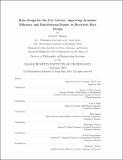Rate design for the 21st Century : improving economic efficiency and distributional equity in electricity rate
Author(s)
Burger, Scott P.
Download1135985737-MIT.pdf (7.700Mb)
Alternative title
Improving economic efficiency and distributional equity in electricity rate
Other Contributors
Massachusetts Institute of Technology. Institute for Data, Systems, and Society.
Advisor
Ignacio J. Pérez-Arriaga.
Terms of use
Metadata
Show full item recordAbstract
Electricity tariffs typically charge residential users a volumetric (that is, per-unit of electricity consumed) price that recovers the bulk of the costs of generating, transmitting, and distributing electrical energy. These tariffs also often include taxes and recover other costs associated with regulatory or policy measures. The resulting prices do not reflect the true social marginal costs of generating, transmitting, and distributing energy, capturing little or none of the temporal and geographic variability of marginal electricity costs. These inefficient rates incentivize customers to over-consume power during periods of peak system stress and under-consume power during periods of relatively low demand; this dynamic drives up power system costs, costing Americans and Europeans tens of billions of dollars annually. Critically, it leads to investments in long-lived and low-utilization infrastructure needed to meet peak demands. Economists have long argued for reforming rates, but progress has historically been slow. Today, less than one quarter of one percent of residential electricity customers in the United States pay a tariff that reflects the real-time price of energy. The emergence of distributed energy resources -- such as solar photovoltaics and battery energy storage -- has sparked renewed interest among regulators and utilities in reforming electricity tariffs. Efficient rates hold the potential to improve the economic efficiency of distributed energy resource installation and operation decisions. However, the economic pressure to redesign electricity rates is countered by concerns of how more efficient rate structures might impact different socioeconomic groups. In particular, regulators have been dubious of efforts to reform how the costs of network infrastructure (that is, transmission and distribution networks) are recovered, rejecting more than 75% of such efforts in the U.S. in 2017. Focusing on developed power systems in contexts like the U.S. and Europe, this Thesis examines the distributional impacts of rate reform and proposes methods to improve the economic efficiency of rates without creating undesirable distributional impacts. This Thesis also explores the distributional impacts of rooftop solar photovoltaics adoption under alternative rate designs. This Thesis leverages data on electricity consumption measured half-hourly for more than 100,000 customers in the Chicago, Illinois area, paired with Census data to gain unprecedented insight into the impacts of reforming electricity pricing across customers of varying socioeconomic statuses. This Thesis then builds a simple model of the local utility's -- Commonwealth Edison's -- cost of service, and simulates solar PV adoption under alternative rate designs, measuring the impacts on customers of differing income levels. This Thesis demonstrates that low-income customers would face increases in expenditures on average in a transition to rates that recover residual network and policy costs through economically efficient fixed charges. However, this Thesis demonstrates that simple changes to fixed charge designs can mitigate these disparities while preserving all, or the vast majority, of the efficiency gains. These designs rely exclusively on observable information and could be replicated by utilities in many geographies across the U.S. Rooftop solar PV adoption under tariffs with inefficient, volumetric residual cost recovery are shown to create substantial distributional challenges: PV adoption under such tariffs increases expenditures substantially for non-adopters, which tend to be predominately lower income customers; efficient tariffs prevent this regressive cost shifting. In short, failing to reform rates may lead to worse distributional outcomes than reforming rates, even if reforms are implemented naively. Collectively, the findings in this Thesis underscore the need for regulatory reform around electricity pricing, and chart a path forward for balancing economic efficiency and distributional equity in public utility pricing.
Description
This electronic version was submitted by the student author. The certified thesis is available in the Institute Archives and Special Collections. Thesis: Ph. D. in Engineering Systems, Massachusetts Institute of Technology, School of Engineering, Institute for Data, Systems, and Society, 2019 Cataloged from student-submitted PDF version of thesis. Includes bibliographical references (pages 241-257).
Date issued
2019Department
Massachusetts Institute of Technology. Institute for Data, Systems, and Society; Massachusetts Institute of Technology. Engineering Systems DivisionPublisher
Massachusetts Institute of Technology
Keywords
Institute for Data, Systems, and Society.